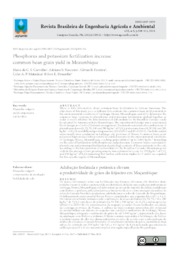Phosphorus and potassium fertilization increase common bean grain yield in Mozambique.
Phosphorus and potassium fertilization increase common bean grain yield in Mozambique.
Author(s): CARVALHO, M. da C. S.; NASCENTE, A. S.; FERREIRA, G. B.; MUTADIUA, C. A. P.; DENARDIN, J. E.
Summary: There is little information about common bean fertilization in African Savannas. The objectives of this study were as follows: i) to evaluate the common bean yield potential in the environmental conditions of Lichinga, Niassa, Mozambique, and ii) to determine the common bean response to phosphorus and potassium fertilization applied together in order to verify whether the interpretation of soil analysis for the Brazilian Cerrado could be adopted for Savanna soils in Mozambique. The experimental design was a randomized block design in a 5 x 4 x 2 factorial arrangement. Treatments consisted of a combination of phosphorus doses (0, 35, 70, 140 and 280 kg ha-1 of P2O5), potassium doses (0, 50 100 and 200 kg ha-1 of K2O), and different growing seasons (2012/2013 and 2013/2014). The field rainfed experiments were conducted in Lichinga city, province of Niassa. Common bean crops presented high productivity potential in rainfed systems in the environmental conditions of Lichinga, Niassa, Mozambique, reaching grain yields of up to 3,600 kg ha-1 depending on the rates of fertilization with phosphorus and potassium. Common beans responded to phosphorus and potassium fertilization despite high contents of these nutrients in the soil, according to the interpretation of soil analysis for the Brazilian Cerrado. Maximum grain yield in the average of two growing seasons was estimated to occur for 239 kg ha-1 of P2O5 and 141 kg ha-1 of K2O, indicating that further calibration studies for P and K are required for this specific region of Mozambique.
Publication year: 2018
Types of publication: Journal article
Unit: Embrapa Rice & Beans
Observation
Some of Embrapa's publications are published as ePub files. To read them, use or download one of the following free software options to your computer or mobile device. Android: Google Play Books; IOS: iBooks; Windows and Linux: Calibre.
Access other publications
Access the Agricultural Research Database (BDPA) to consult Embrapa's full library collection and records.
Visit Embrapa Bookstore to purchase books and other publications sold by Embrapa.

